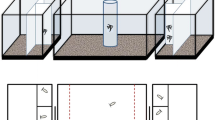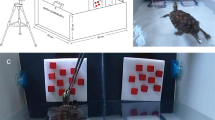Abstract
Discriminating between different quantities is an essential ability in daily life that has been demonstrated in a variety of non-human vertebrates. Nonetheless, what drives the estimation of numerosity is not fully understood, as numerosity intrinsically covaries with several other physical characteristics. There is wide debate as to whether the numerical and spatial abilities of vertebrates are processed by a single magnitude system or two different cognitive systems. Adopting a novel approach, we aimed to investigate this issue by assessing the interaction between area size and numerosity, which has never been conceptualized with consideration for subjective experience in non-human animals. We examined whether the same perceptual biases underlying one of the best-known size illusions, the Delboeuf illusion, can be also identified in numerical estimation tasks. We instructed or trained human participants and guppies, small teleost fish, to select a target numerosity (larger or smaller) of squares between two sets that actually differed in their numerosity. Subjects were also presented with illusory trials in which the same numerosity was presented in two different contexts, against a large and a small background, resembling the Delboeuf illusion. In these trials, both humans and fish demonstrated numerical biases in agreement with the perception of the classical version of the Delboeuf illusion, with the array perceived as larger appearing more numerous. Thus, our results support the hypothesis of a single magnitude system, as perceptual biases that influence spatial decisions seem to affect numerosity judgements in the same way.





Similar content being viewed by others
Data availability
The data that support the findings of this study are available from the corresponding author upon request.
References
Agrillo C, Miletto Petrazzini ME (2013) Glimpse of ATOM in non-human species? Front Psychol 4:460
Agrillo C, Piffer L, Bisazza A (2011) Number versus continuous quantity in numerosity judgments by fish. Cognition 119:281–287
Agrillo C, Piffer L, Adriano A (2013) Individual differences in non-symbolic numerical abilities predict mathematical achievements but contradict ATOM. Behav Brain Funct 9:1–14
Agrillo C, Santacà M, Pecunioso A, Miletto Petrazzini ME (2020) Everything is subjective under water surface, too: visual illusions in fish. Anim Cogn 23:251–264
Beran MJ (2008) The evolutionary and developmental foundations of mathematics. PLoS Biol 6:221–224
Bertamini M, Guest M, Vallortigara G, Rugani R, Regolin L (2018) The effect of clustering on perceived quantity in humans (Homo sapiens) and in chicks (Gallus gallus). J Comp Psychol 132:280
Bevan W, Turner ED (1964) Assimilation and contrast in the estimation of number. J Exp Psychol 67:458
Bevan W, Maier RA, Helson H (1963) The influence of context upon the estimation of number. Am J Psychol 76:464–469
Bisazza A, Agrillo C, Lucon-Xiccato T (2014) Extensive training extends numerical abilities of guppies. Anim Cogn 17:1413–1419
Bortot M, Regolin L, Vallortigara G (2020) A sense of number in invertebrates. Biochem Bioph Res Comm 564:37–42
Butterworth B, Reeve R, Reynolds F (2011) Using mental representations of space when words are unavailable: studies of enumeration and arithmetic in indigenous Australia. J Cross Cult Psychol 42:630–638
Butterworth B, Gallistel CR, Vallortigara G (2018) Introduction: the origins of numerical abilities. Philos T Roy Soc B 373:20160507
Cohen J (1988) Statistical power analysis for the behavioral sciences, 2nd edn. Erlbaum, Hillsdale
Dakin SC, Tibber MS, Greenwood JA, Morgan MJ (2011) A common visual metric for approximate number and density. P Natl Acad Sci Usa 108:19552–19557
De Hevia MD, Girelli L, Bricolo E, Vallar G (2008) The representational space of numerical magnitude: Illusions of length. Q J Exp Psychol 61:1496–1514
De Smedt B, Noël MP, Gilmore C, Ansari D (2013) How do symbolic and non-symbolic numerical magnitude processing skills relate to individual differences in children’s mathematical skills? a review of evidence from brain and behavior. Trends Neurosci Educ 2:48–55
Dormal V, Andres M, Pesenti M (2008) Dissociation of numerosity and duration processing in the left intraparietal sulcus: a transcranial magnetic stimulation study. Cortex 44:462–469
Dormal V, Larigaldie N, Lefèvre N, Pesenti M, Andres M (2018) Effect of perceived length on numerosity estimation: evidence from the müller-lyer illusion. Q J Exp Psychol 71:2142–2151
Droit-Volet S, Clément A, Fayol M (2008) Time, number and length: similarities and differences in discrimination in adults and children. Q J Exp 61:1827–1846
Feigenson L, Dehaene S, Spelke E (2004) Core systems of number. Trends Cogn Sci 8:307–314
Gallistel CR (1990) The organization of learning. The MIT Press, Cambridge
Gallistel CR, Gelman R (2000) Non-verbal numerical cognition: from reals to integers. Trends Cogn Sci 4:59–65
Gebuis T, Reynvoet B (2012) The role of visual information in numerosity estimation. PLoS ONE 7:e37426
Gelman R, Butterworth B (2005) Number and language: how are they related? Trends Cogn Sci 9:6–10
Halberda J, Mazzocco MM, Feigenson L (2008) Individual differences in non-verbal number acuity correlate with maths achievement. Nature 455:665–668
Hyde DC (2011) Two systems of non-symbolic numerical cognition. Front Hum Neurosci 5:150
Kaufmann L, Koppelstaetter F, Delazer M, Siedentopf C, Rhomberg P, Golaszewski S, Ischebeck A (2005) Neural correlates of distance and congruity effects in a numerical stroop task: an event-related fMRI study. Neuroimage 25:888–898
King DL (1988) Assimilation is due to one perceived whole and contrast is due to two perceived wholes. New Ideas Psychol 6:277–288
Leibovich-Raveh T, Raveh A, Vilker D, Gabay S (2021) Magnitude integration in the Archerfish. Sci Rep 11:1–10
Lucon-Xiccato T, Santacà M, Miletto Petrazzini ME, Agrillo C, Dadda M (2019) Guppies, Poecilia reticulata, perceive a reversed delboeuf illusion. Anim Cogn 22:291–303
Decreto Legislativo 4 marzo 2014: Attuazione della direttiva 2010/63/UE sulla protezione degli animali utilizzati a fini scientifici, n. 26 (2014) https://www.gazzettaufficiale.it/eli/id/2014/03/14/14G00036/sg
Miletto Petrazzini ME, Brennan CH (2020) Application of an abstract concept across magnitude dimensions by fish. Sci Rep 10:1–7
Miletto Petrazzini ME, Agrillo C, Piffer L, Dadda M, Bisazza A (2012) Development and application of a new method to investigate cognition in newborn guppies. Behav Brain Res 233:443–449
Nieder A (2019) A brain for numbers: the biology of the number instinct. MIT press, Cambridge
Nieder A, Dehaene S (2009) Representation of number in the brain. Annu Rev Neurosci 32:185–208
Pecunioso A, Miletto Petrazzini ME, Agrillo C (2020) Anisotropy of perceived numerosity: evidence for a horizontal–vertical numerosity illusion. Acta Psychol 205:103053
Picon E, Dramkin D, Odic D (2019) Visual illusions help reveal the primitives of number perception. J Exp Psychol Gen 148:1675
Revkin SK, Piazza M, Izard V, Cohen L, Dehaene S (2008) Does subitizing reflect numerical estimation? Psychol Sci 19:607–614
Santacà M, Agrillo C (2020a) Perception of the müller-lyer illusion in guppies. Curr Zool 66:205–213
Santacà M, Agrillo C (2020b) Two halves are less than the whole: evidence of a length bisection bias in fish (Poecilia reticulata). PLoS ONE 15:e0233157
Santacà M, Agrillo C, Miletto Petrazzini ME (2021) The challenge of illusory perception of animals: the impact of methodological variability in cross-species investigation. Animals 11:1618
Santacà M, Bisazza A, Agrillo C (2022) Guppies (Poecilia reticulata) are deceived by visual illusions during obstacle negotiation. Biol Letters 18:20210548
Uller C, Carey S, Huntley-Fenner G, Klatt L (1999) What representations might underlie infant numerical knowledge? Cognitive Dev 14:1–36
Vallortigara G (2018) Comparative cognition of number and space: the case of geometry and of the mental number line. Philos T Roy Soc B 373:20170120
Van Rinsveld A, Guillaume M, Kohler PJ, Schiltz C, Gevers W, Content A (2020) The neural signature of numerosity by separating numerical and continuous magnitude extraction in visual cortex with frequency-tagged EEG. P Natl Acad Sci USA 117:5726–5732
Vos PG, Van Oeffelen MP, Tibosch HJ, Allik J (1988) Interactions between area and numerosity. Psychol Res 50:148–154
Walsh V (2003) A theory of magnitude: common cortical metrics of time, space and quantity. Trends Cogn Sci 7:483–488
Xu F (2003) Numerosity discrimination in infants: evidence for two systems of representations. Cognition 89:B15–B25
Xu F, Spelke ES (2000) Large number discrimination in 6-month-old infants. Cognition 74:B1–B11
Yousif SR, Keil FC (2021) How we see area and why it matters. Trends Cogn Sci 25:554–557
Acknowledgements
We performed the present work within the scope of the research grant ‘Dipartimenti di Eccellenza’ (art.1, commi 314–337 legge 232/2016) entitled ‘Innovative methods or technologies for assessment, intervention, or enhancement of psychological functions (cognitive, emotional or behavioural)’. We thank Giada Alessi for her help in testing the fish.
Author information
Authors and Affiliations
Contributions
MS conceived and designed both experiments, performed the experiments with fish, analysed the data, and drafted the manuscript. UG conceived and designed the experiment with humans, analysed the data, and drafted the manuscript. Both authors gave final approval for publication. All authors read and approved the final manuscript.
Corresponding author
Ethics declarations
Conflict of interests
The authors declare no competing interests.
Ethical approval
The experiment with humans was approved by the ethics committee (Protocol no. 3796) of the Department of General Psychology at the University of Padova (Italy). Regarding the experiment with fish, we followed all applicable international, national, and/or institutional guidelines for the care and use of animals (Italy, D.L. 4 Marzo 2014, no. 26). The experiment was in accordance with the ethical standards of the institution where the study was conducted and was approved by the relevant ethics committee (Organismo preposto al benessere animale) of the University of Padova (Protocol no. 32/2019).
Additional information
Publisher's Note
Springer Nature remains neutral with regard to jurisdictional claims in published maps and institutional affiliations.
Supplementary Information
Below is the link to the electronic supplementary material.
Rights and permissions
Springer Nature or its licensor (e.g. a society or other partner) holds exclusive rights to this article under a publishing agreement with the author(s) or other rightsholder(s); author self-archiving of the accepted manuscript version of this article is solely governed by the terms of such publishing agreement and applicable law.
About this article
Cite this article
Santacà, M., Granziol, U. The influence of visual illusion perception on numerosity estimation could be evolutionarily conserved: exploring the numerical Delboeuf illusion in humans (Homo sapiens) and fish (Poecilia reticulata). Anim Cogn 26, 823–835 (2023). https://doi.org/10.1007/s10071-022-01721-6
Received:
Revised:
Accepted:
Published:
Issue Date:
DOI: https://doi.org/10.1007/s10071-022-01721-6




